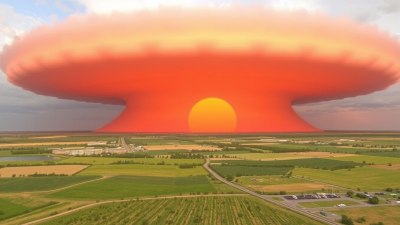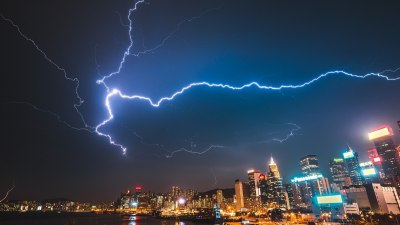The Real Reason Summer Storms Are So Violent
Explore why summer storms often turn violent, uncovering the meteorological factors behind their intensity and the impact on affected regions.

Summer storms are a hallmark of the warm months, characterized by their sudden onset and often intense nature. While many enjoy a summer thunderstorm for the brief respite it offers from the heat, others experience the destructive force these storms can unleash. Understanding the real reasons behind the violence of summer storms requires a deep dive into atmospheric conditions, geographic factors, and climate influences.
Atmospheric Dynamics Behind Summer Storms
The violence of summer storms primarily stems from the unique atmospheric dynamics prevalent during this season. Unlike winter storms, which often spread over large areas and develop slowly, summer storms tend to be localized but extremely powerful. The key driving factor is the presence of strong convection currents created by intense solar heating of the earth’s surface.
During summer, longer daylight hours and higher sun angles result in significant warming of the ground. This heating causes the air directly above the surface to warm rapidly, becoming lighter and rising. As the warm, moist air ascends, it cools and condenses to form clouds, releasing latent heat, which further fuels the upward motion. This convection process is essential for thunderstorm development and contributes to the rapid intensification of storms.
Above the convective zone, the atmosphere often features cooler and drier air, creating a pronounced temperature gradient with the warm surface air. This atmospheric instability is a critical factor in the strength of summer storms. The greater the instability, the more violent the storm tends to be because air parcels rise vigorously, promoting the formation of towering cumulonimbus clouds, known for producing heavy rain, hail, lightning, and strong winds.
Humidity and Moisture Content
Another crucial ingredient for violent summer storms is the high humidity typical of the season. Warm air holds more moisture than cold air, and summer months often see elevated humidity levels, especially in coastal and tropical regions. This abundant moisture content fuels storm clouds, allowing them to grow larger and sustain heavy precipitation.
Higher humidity also intensifies the latent heat release during condensation, which in turn strengthens the updrafts within a thunderstorm. Strong updrafts can carry moisture high into the atmosphere, enabling the formation of hailstones and increasing the likelihood of severe weather phenomena. As a result, storms become not only more intense but also more destructive in nature.
Wind Shear and Storm Structure
Wind shear, the change in wind speed and direction with height, plays a significant role in determining the severity of summer storms. Moderate to strong wind shear can tilt the storm structure, preventing the precipitation from falling back into the updraft and effectively sustaining the storm for longer periods.
This process leads to the formation of organized storm systems capable of producing severe weather such as tornadoes and damaging straight-line winds. In regions prone to wind shear, summer storms can evolve into powerful supercells, which are responsible for many of the most violent thunderstorms and associated tornado outbreaks.
Geographic and Regional Influences
The geographical location significantly impacts the frequency and intensity of summer storms. Coastal areas, mountain regions, and plains each experience summer storms differently due to local topography and proximity to moisture sources.
Coastal plains, in particular, often deal with tropical moisture flowing inland, while mountain regions experience orographic lift—where moist air is forced to rise over terrain, cooling and condensing to initiate storms. The Great Plains of the United States, often dubbed “Tornado Alley,” benefit from the convergence of moist Gulf air and dry air masses from the west, creating an ideal environment for violent summer storms.
Additionally, urban heat islands can intensify summer storms. Cities absorb and retain more heat than rural areas, increasing surface temperatures and enhancing convection locally. This effect can heighten the frequency and strength of storms directly over urban centers, leading to localized flooding and property damage.
Role of Solar Radiation and Daylight Length
High solar radiation during summer months heats the earth's surface more intensely than in other seasons. This influx of energy is the engine driving convection currents essential for storm development. Longer daylight hours allow for more sustained heating, progressively warming the surface over the course of the day.
Late afternoon and early evening are typically peak times for summer storms as the accumulated surface heat maximizes atmospheric instability. Post-sunset, the cooling surface tends to stabilize the atmosphere, leading to a diminishment in storm activity.
Climate Change and Summer Storm Intensity
Recent studies suggest that climate change may be contributing to increasing violence in summer storms. Warmer global temperatures elevate sea surface temperatures and atmospheric moisture content, thereby providing greater energy for storm systems.
Increased moisture amplifies latent heat release, potentially making storms more intense and prolonging their duration. Furthermore, shifts in atmospheric circulation patterns might change where and when summer storms occur, possibly increasing the risk in regions that were previously less affected.
Research also indicates that the frequency of extreme precipitation events is rising worldwide, aligning with the theory that warming accelerates the hydrological cycle. This trend suggests that violent summer storms with heavy rainfall may become more common in the coming decades, emphasizing the need for improved forecasting and adaptation strategies.
Common Characteristics of Violent Summer Storms
Violent summer storms often showcase several recognizable features. These include towering cumulonimbus clouds reaching heights of 30,000 to 60,000 feet, intense lightning activity, strong downdrafts generating gusty winds, frequent heavy rain showers, and hail. Tornado formation, while less common, is also a hallmark of the most severe storms.
These storms develop rapidly and can produce flash flooding due to the high rainfall rates typical of summer convection. Their sudden nature and localized intensity make them difficult to predict accurately ahead of time, posing significant risks to life and property.
Lightning and Electrical Activity
Lightning is a dramatic and dangerous trait of summer storms. It results from the buildup of electrical charges within storm clouds, created by colliding ice crystals and water droplets in a turbulent environment. The electrical discharge neutralizes these charges, producing lightning bolts.
Summer storms’ powerful updrafts and large cloud sizes facilitate vast regions of charge separation, making lightning more frequent and intense. These lightning strikes can lead to wildfires, power outages, and injuries, illustrating how summer storms can have multifaceted impacts.
Impact on Ecosystems and Human Activity
While often destructive, summer storms also play a critical role in maintaining ecological balance. They replenish groundwater, sustain plant life, and regulate temperatures. However, violent storms can cause erosion, damage crops, and disrupt transportation and communication networks.
Urban and suburban areas must prepare for heavy rainfall that can overwhelm drainage systems, leading to flash floods. Regions dependent on agriculture are particularly vulnerable to crop damage from hail and strong winds.
The unpredictability and intensity of summer storms necessitate public awareness campaigns and the development of robust infrastructure to mitigate their impacts.
Modern Techniques in Predicting Summer Storms
Advancements in meteorology have improved the ability to forecast summer storms, yet challenges remain due to their localized nature and rapid evolution. Weather radar technology, satellite imaging, and high-resolution computer models contribute to early detection and real-time tracking.
Meteorologists analyze atmospheric soundings measuring temperature, humidity, and wind at various altitudes to assess instability and shear. Alerts and warnings based on these analyses help communities prepare for imminent storms.
Despite progress, predicting the precise timing and severity of summer storms remains complex because small-scale processes within the atmosphere can evolve suddenly, requiring continuous research and technological improvements.
Historic Examples of Violent Summer Storms
History provides numerous instances of violent summer storms with devastating effects. For example, the July 2011 super outbreak in the United States produced over 300 tornadoes in just a few days, many accompanied by large hail and damaging winds. Another notable event includes the severe thunderstorms that struck Europe in summer 2002, causing extreme flooding and infrastructure damage.
These events underscore the potential for violence when ideal atmospheric conditions converge. They also highlight the importance of understanding the mechanisms behind storm formation to improve response and resilience.
Safety Measures During Violent Summer Storms
Preparedness is vital during the summer storm season. Individuals should stay informed via weather alerts, seek shelter indoors during storms, avoid flood-prone areas, and secure loose outdoor objects that could become hazards in strong winds.
Communities should invest in resilient infrastructure, including flood defenses and emergency response systems. Educating the public on recognizing storm warnings and taking appropriate action can significantly reduce injuries and fatalities.
Emergency kits containing essentials such as water, food, flashlights, and batteries are recommended for all households in storm-prone regions to improve self-sufficiency during events.
Violence in summer storms is chiefly a result of intense solar heating, abundant moisture, atmospheric instability, and wind shear. These factors combine to produce powerful thunderstorms capable of generating heavy rain, hail, lightning, and tornadoes. Geographic and climatic influences further modulate their intensity and frequency.
As climate change continues to affect global weather patterns, the potential for violent summer storms may increase, emphasizing the importance of scientific understanding and preparedness. Through improved forecasting, infrastructure development, and public education, the impacts of these storms can be mitigated, safeguarding lives and property.
Understanding the real reasons behind the intensity of summer storms deepens appreciation for the delicate balance of meteorological forces at play and highlights the enduring challenge of living harmoniously with nature’s powerful displays.











